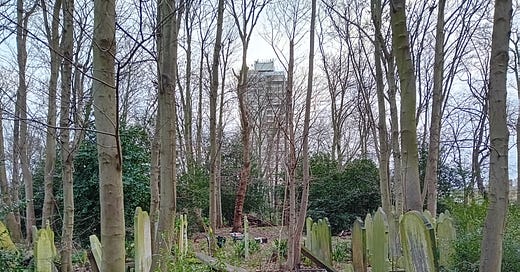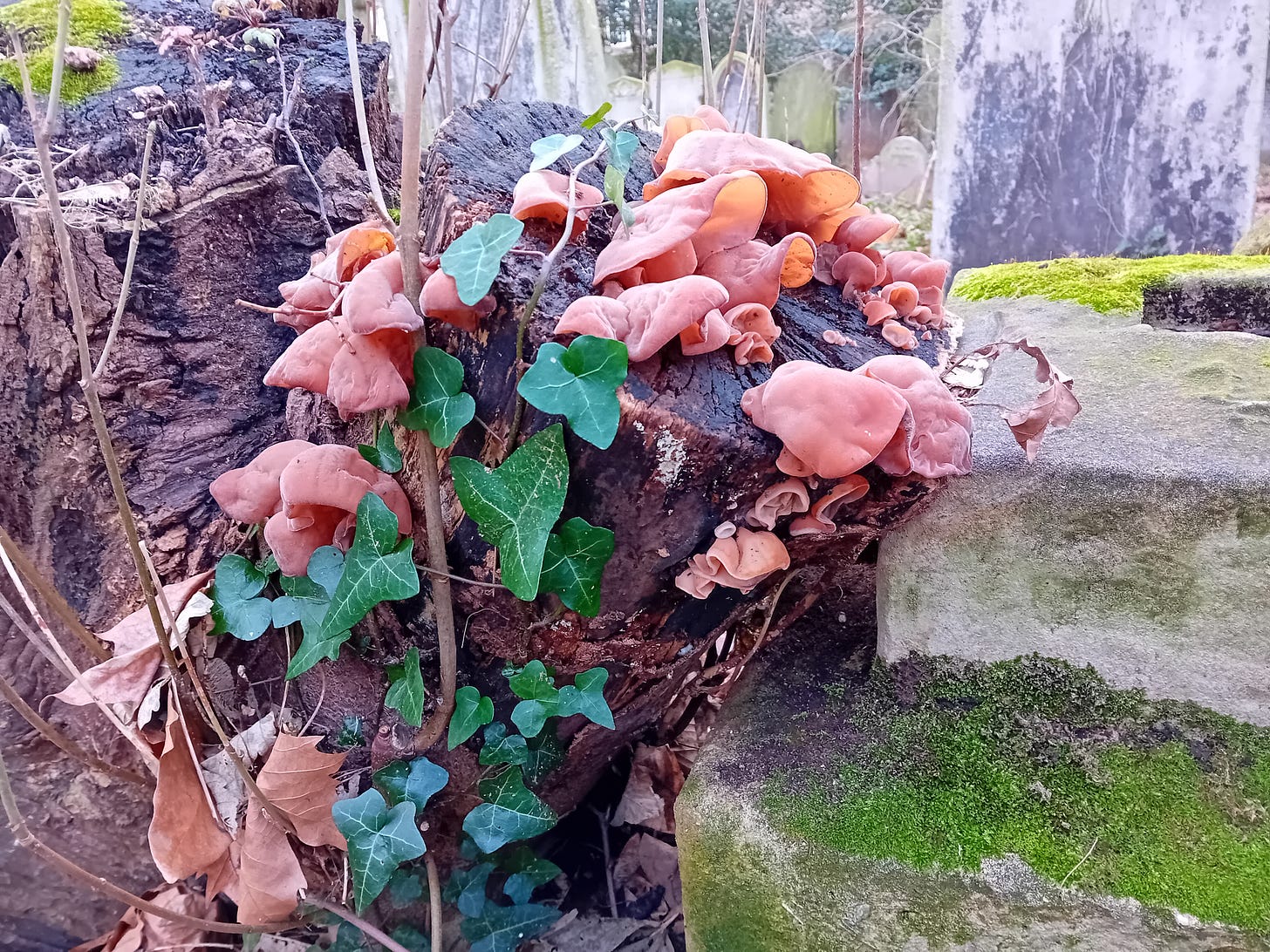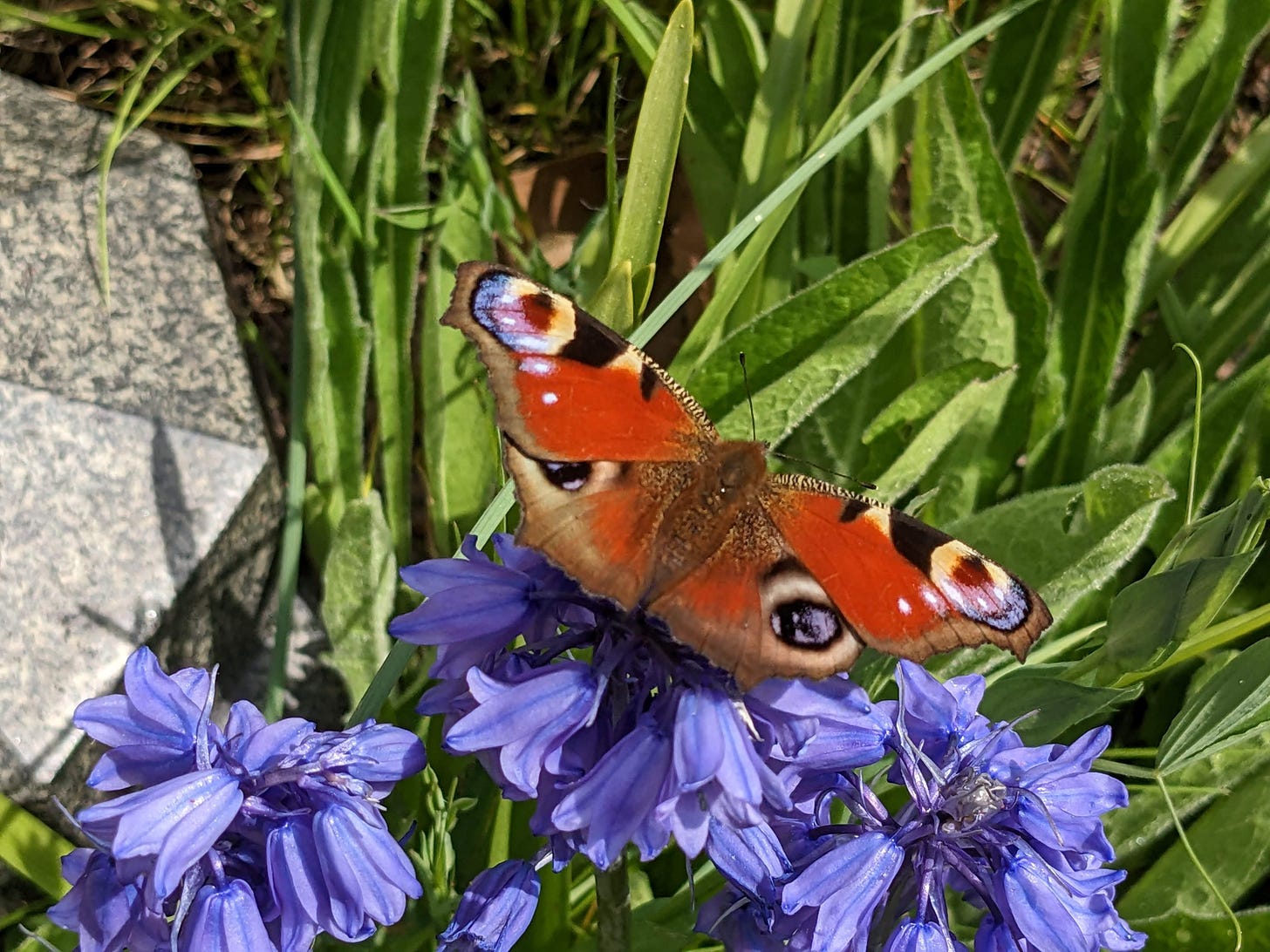For one of my recent volunteering sessions, instead of heading towards the edge of London, I travelled further into the metropolis. As I stepped out of the tube station, I was surrounded by the noise and smell of vehicles on the busy Mile End Road. A few minutes later I was in Tower Hamlets Cemetery Park, the nearby tower blocks still just visible through the winter-bare trees but the traffic now barely noticeable.
Tower Hamlets is the most densely populated local authority area in England and also one of the most diverse – at least 90 different languages are spoken here. The borough’s boundaries include the gleaming steel and concrete towers at Canary Wharf as well as some of the highest levels of social deprivation in the country. For such a densely built-up area there’s a surprising amount of green space but there is nowhere else quite like the Cemetery Park, London’s most central woodland, a place that offers an escape from the surrounding city.
Tower Hamlets Cemetery opened in 1841. It was the last of the ‘Magnificent Seven’ Cemeteries to be built in Victorian London but was less commercially successful than others such as Highgate and Brompton. Over a quarter of a million burials had taken place here by 1889, but by the end of the nineteenth century the cemetery was already suffering from neglect. Largely abandoned for much of the first half of the twentieth century, it became very overgrown, and by the time legislation was passed to convert it into an open space in the 1960s, it was a place most local people were reluctant to visit.
Now it’s a very different place. Since 1990 it’s been looked after by the Friends of Tower Hamlets Cemetery Park (FoTHCP) and a couple of staff are employed to ensure the site is safe and welcoming for all. As well as the usual litter-picking and bin-emptying involved in running any Park, FoTHCP organise guided walks, crafting activities and other events aimed at encouraging more people to experience the nature and heritage. And there’s lots of volunteering too – not only the nature conservation volunteering that I was here for, but heritage volunteering too, for people interested in helping research the history of those buried in the cemetery. While some of the other Magnificent Seven Cemeteries may have more famous occupants Tower Hamlets has some very moving stories. The burials here include several of those killed in the Bethnal Green tube disaster of 1943, the single largest loss of civilian life in the UK during World War Two, when 173 people were crushed on a stairway as they tried to shelter from an air raid.
The cemetery has been transformed from somewhere to be avoided to a place that regularly wins London in Bloom awards in recognition of the care with which it is looked after. What’s really special about this place, is that it provides an opportunity for people to experience the natural world as part of their everyday lives as they walk through the Cemetery Park on the way to the shops or to school or to the tube station. This kind of nearby nature is particularly important in an area where many residents have neither access to a garden at home, nor the time and money to travel to wilder places further away. As I know from my own experience such places became particularly important during the pandemic when those of us without cars were very restricted on where we could go.
I’ve loved the Cemetery Park since the first time I visited five or six years ago, and last year I became a Trustee of FoTHCP but this was the first time I’d done any conservation volunteering here. Much about it was similar to my experiences elsewhere. The other volunteers were friendly, there were some great fungi-spotting opportunities - including a tree stump completely covered in jelly ear fungus - and our task was to remove unwanted vegetation. This time the focus was on taking out the bramble, ivy and holly that had taken over a section of the Cemetery to give other plants more chance to grow. But working in a cemetery brought new challenges. We needed to take great care when removing ivy from the gravestones to avoid damaging them. And another novelty for me was that when we stopped for lunch, we could sit inside the recently refurbished Cemetery Park Lodge to eat our sandwiches. The warmth and a proper seat were both very welcome, but I did miss spending a whole day immersed in the woods as I usually do when out volunteering.
The Cemetery Park is designated as a Local Nature Reserve and like many urban cemeteries it’s a haven for wildlife. As the land has never been “improved” for farming or to create the kind of amenity grassland found in parks, cemeteries often contain species that have largely been lost from areas where intensive agriculture has been practiced for decades. In springtime, parts of my local cemetery, Brockley and Ladywell, are filled with the kind of wildflowers like cuckooflower which would have flourished when this area was still farmland. At Tower Hamlets Cemetery Park, volunteers have recorded over ninety species of birds and 31 species of butterflies including rare species such as the Small Blue, demonstrating just how important it is to have a place like this in Inner London, a place where both wildlife and humans can thrive.
To finish….
…a few things I’d like to share:
Wildlife in an Urban Cemetery: This short Youtube video illustrates beautifully just how valuable urban cemeteries are for wildlife. The person who made it intentionally doesn’t say where the cemetery is as they want to protect the creatures they’ve filmed which include a muntjac deer and a green woodpecker.
Field Notes from a Hidden City: An urban nature diary by Esther Woolfson. Woolfson describes the wildlife she encounters over the course of a year, most of which is within walking distance of her home in Aberdeen. The book is full of fascinating details about the creatures she meets and which she obviously pays very close attention to, and it demonstrates just how much wildlife there is in cities if we look closely enough.
The Unofficial Countryside by Richard Mabey. Published in 1973, this is one of the earliest celebrations of the nature that thrives in cities and the way that wildlife has adapted to live alongside humans. It is also the book which provided the title for this newsletter. Mabey believes that it’s [the] sense that life can go on with a different set of priorities to our own that makes the persistence of wildlife in urban areas so valuable. His focus is primarily on environments that have been extensively shaped by human activity in recent times including canals, railway embankments, gravel pits, golf courses, parks and gardens but Mabey also writes about the value of churches and churchyards for urban wildlife.







This is great! I lived in Stratford for several years and have never been to Tower Hamlets Cemetery- I’ll check it out! Are you familiar with Abney Park in Stoke Newington? It’s very lovely also.